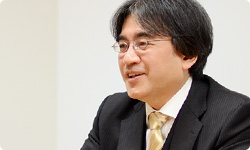4. Just Before Putting It on ROM
Why do you at Grezzo think that of all the games out there The Legend of Zelda: Ocarina of Time was so special?
It is the representative polygon 3D game. I feel like it is a title in which energy and a challenging spirit exploded in a way that said, “This is what can be done!” As a series goes along, rules usually appear. But with The Legend of Zelda: Ocarina of Time, there were no rules to making it.
It is true that the Nintendo 64 version of The Legend of Zelda: Ocarina of Time came along when video games were changing from 2D to 3D. Since the old 2D rules weren’t applicable, everything was made from scratch. Everyone was groping their way forward in the dark, but for some reason there was an odd confidence and faith that they would definitely make it out into the light, and that spirit possessed the whole thing.

Something I thought was particularly great with regard to the degree of completion in level design is how the developers didn’t simply make maps, but calculated how it would look to Link standing there. In the early days of polygon 3D, it’s quite a wonder that they would think of that.
Aonuma-san, did you make precise calculations?
It would be cool if I could say yes, but... (laughs)
You didn’t make precise calculations, but you did try it over and over again to make it look just right.
Yes. I couldn’t decide when to call it quits.
Iwata Asks: The Legend of Zelda: Ocarina of Time 3D was how everyone was happy when the due date got pushed back. Usually, people are exhausted and think, “And so the marathon drags on...” But the team back then was having too much of a good time!
It was demanding, but fun.
When you talk to creators of a title adored by fans, they usually say, “It was hard, but fun.” That also applies to The Legend of Zelda: Ocarina of Time.
Tonooka-san, what do you think?
Well, when I received the old program, I thought that all of the creators must have been in high spirits. In the comments box of the source program, someone had written something like, “We got an extension. I’m worried about my bonus. But at least now we can make this.” (laughs)
Huh? Really?!
Yes. (laughs) And that enthusiasm of the programmers back then inspired us.
It would be hard to hold back after seeing that.
Absolutely. (laughs) So we really dedicated ourselves to it. And while it applies to the whole Legend of Zelda series, The Legend of Zelda: Ocarina of Time feels hand-made. Usually, programmers like to make a system and rules, but The Legend of Zelda isn’t a game to quietly conform to those things. The source program itself feels hand-made down to the finest details.
It isn’t systematic. It’s a conglomeration of elements made by individual craftsmen, but a conglomeration that hangs together as a total.
That’s right. When players get their hands on it, the creators’ passion comes across. That may be why players rate it so highly.
Moriya-san, what did you think about The Legend of Zelda: Ocarina of Time?
Unfortunately, I didn’t play the original when it came out, but as I played it during development, I thought, “This game is an adventure!” As I was playing, I suddenly recalled the mountain where I used to play as a child, so I think other players must have similar experiences. I felt like I knew why the game is so loved.

I see. This project began as remaking The Legend of Zelda: Ocarina of Time, but in the end we put in many elements tailored specifically for the Nintendo 3DS system. The first one that comes to mind is the ability to control where Link is looking using the gyro sensor built into the system . Why did you put that in?
Before Nintendo Conference 20109, Aonuma-san said we had to use the gyro sensor. 9Nintendo Conference 2010: An exhibition for professionals in the gaming industry held at Makuhari Messe in Japan on September 29, 2010.
About one week before, right?
About one week beforehand? Aonuma-san, what exactly was it you wanted to do with the gyro sensor?
I didn’t want to move the camera with the analog control. This has something to do with changing the line of sight by pointing in The Legend of Zelda: Twilight Princess10 for the Wii console. When you push an analogue stick, we can make it work both ways so that the camera moves up or down, so there are two answers, but with a gyro sensor, they become one. That is something (Shigeru) Miyamoto-san has been saying he wants to fix for some time now. 10The Legend of Zelda: Twilight Princess: An action-adventure game released for the Wii console and the Nintendo GameCube system in December 2006.
Well, there are times when the gyro sensor alone isn’t enough, so we also made it so you can use the analogue control. Then Moriya-san made it so you can switch back and forth between the gyro sensor and analogue control seamlessly. You can choose on or off.
But then in the end, Miyamoto-san...
Right. He gave us a little push. (laughs)
At first, you could only use the gyro sensor to control line of sight in first-person mode when using items and moving the camera from Link’s point of view. But at the end of development, two weeks before making the final ROM, right at the last minute, Miyamoto-san said, “Can’t you use the gyro sensor to change the line of sight at normal times when you’re just moving Link around?”
What? But that affects every single scene! That’s not something you say before you create the master ROM.
Yes. Everyone reacted the same way at first. (laughs)
But we tried doing what we could, and it turned out so that when Link is moving around without using L-targeting to lock on, the camera follows him around, and you can use the gyro sensor to look around.
First, we made it with the gyro sensor wide open so you could look around, and then we trimmed away what didn’t work. We had to reach a conclusion in a mere three days.
Right, we might have fallen behind with the ROM. I felt like Miyamoto-san was testing us.
But when we first got that email from Aonuma-san, it was clear that he wanted to do it, so we thought, “I bet Aonuma-san wants to do this.” (laughs)
Huh? Oh, sorry. That is somewhat true. (laughs) I myself had been thinking about allowing players to move the camera using a gyro sensor while Link was moving , but I thought it was impossible since we were so close to putting it on the ROM.
But Miyamoto-san suggested what you couldn’t say yourself, so you asked as if it were a fortunate thing?
Um...yes. We were accomplices. (laughs)
Being able to look around adds a surprising amount of reality to the game world.
It’s like the world of Hyrule is spread out in 360 degrees and you’re peering into the screen at it. I’m really glad we could put that in!